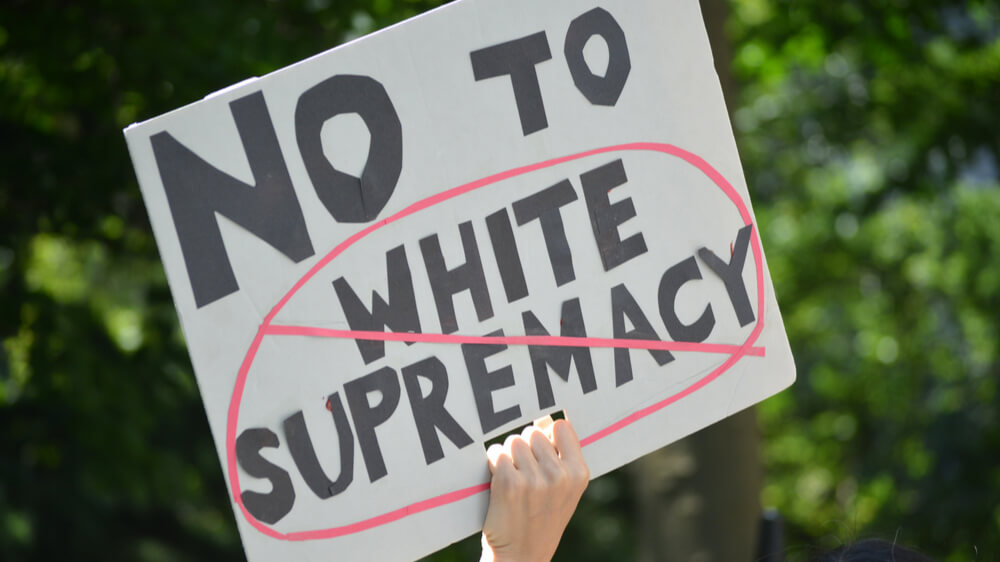Stop Blaming Autism for Capitalist and White Supremacist Violence
Content note: quotation of ableist slurs, discussion of white supremacy, mass violence, Holocaust, and eugenics
In an interview with Talking Points Memo Albert Watkins, the lawyer for self-described “QAnon Shaman” Jacob Chansley, who participated in the January 6th Capitol riots, explained that he planned on making his client’s “Asperger’s” a part of his defense. Chansley, who was photographed during the riots shirtless wearing face paint and a horned furry hat, is perhaps the most recognizable of the rioters who stormed the U.S. Capitol in an attempt to violently refute the results of the 2020 election. Watkins claimed that those on trial for having engaged in an attempted coup against the U.S. government were “all short-bus people. These are people with brain damage, they’re fucking r******d, they’re on the goddamn spectrum.” By claiming that the rioters were disabled, and that their disabilities made them somehow less responsible for their actions, Watkins uses ableist rhetoric to frame the rioters as “other.” And by framing them as “others” Watkins tries to absolve so-called “normal”—that is, non-disabled—Americans of their role in the perpetuation of the white supremacist and anti-democratic ideologies.
Watkins is hardly the first to use disabled people as a scapegoat for the larger structural issues of U.S. society. The same strategy can be seen in media reports on mass shootings. In the wake of a mass shooting there is almost always a frantic attempt to find an explanation for the shooter’s behavior. Journalists, politicians, and the public search for a way to distance the shooter from “mainstream American society,” particularly if the shooter is a white man. This “explanation” often comes in the form of a diagnosis, with autism being the go-to. Autism activists, including the Autistic Self Advocacy Network (ASAN) have condemned this narrative, noting that autism and other developmental disabilities do not cause violence nor white supremacist ideas.
On May 8th, 2021 billionaire Elon Musk revealed that he has Asperger’s as part of his opening monologue on Saturday Night Live (SNL). Musk then quipped that he was “pretty good at running human on emulation mode.” Musk’s appearance on SNL is widely regarded as an attempt to rehabilitate his image after a series of controversies, including his penchant for spreading misinformation about Covid-19, concerns about the environmental impact of SpaceX, his mocking of neo-pronouns on Twitter, and the public’s growing discomfort with the existence of the billionaire class that Musk represents. Rather, than directly address any of these controversies in his opening monologue, Musk denied any responsibility and openly mocked his critics, saying, “to anyone I’ve offended, I just want to say, I reinvented electric cars and I am sending people to mars in a rocket ship, did you think I was also going to be a chill normal dude?” Musk thus framed himself as an eccentric genius whose brilliance lifts him above the plebian norms and consequences of human society. He played into stereotypes that equate autism, and particularly Asperger’s syndrome, with high intelligence and white male entitlement.
At first glance these two events seem to present wildly different narratives of Asperger’s syndrome. Yet a closer look reveals that, while distinct, these two narratives of autism presented by Watkins and Musk both use ableist stereotypes about autism and neurodiversity to excuse structural violence while reinforcing harmful associations between autism and middle and upper-class white masculinity. The all-too-common notion that only white men are autistic erases the existence and contributions of autistic people of color and autistic women.
Watkins’ and Musk’s narratives draw on numerous other problematic stereotypes as well. These include the assumption that disabled people are inherently apolitical, as well as the infantilization of autistic people in popular culture to deny larger political ramifications. Further, Watkins’ attempts to use Chansley’s Asperger’s to explain his client’s participation in a violent attempted coup also perpetuates the stereotype that autistic people are inherently violent. This is particularly concerning, because reinforcing the myth that autistic people are inherently violent can specifically endanger autistic people of color, and particularly Black autistic people, who are already seen as “threatening” simply for existing within their own non-white autistic bodyminds and who are at greater risk of experiencing police brutality.
It is important to address that “Asperger’s” is a contested term. Its namesake, Hans Asperger, was complicit in the Nazi murder of disabled children during the Holocaust. While Asperger was willing to send children who he viewed as “inferior” to the killing wards, he argued that some of his autistic patients could potentially be of use to the Reich as code breakers. This preoccupation with the “usefulness” of autistic people is echoed in contemporary discussions of “functionality” and even online fringe theories about “Aspie Supremacy”. These theories hold that people with Asperger’s Syndrome are the next stage in human evolution. Thus, Asperger’s as a term is heavily associated with inter-disability hierarchies and eugenic notions of superiority and inferiority.
Today, it is a term that is often presented as being the “shiny, glamorous, productive under capitalism” form of autism, largely associated with middle-class white men and boys who are good with computers. This can feel alienating to autistic people of color and autistic women who do not fit within that limited definition of neurodiversity.
While it is unlikely that Watkins or Musk were aware of the specifics of this history, or the full implications of their claims they both implicitly drew on Asperger’s as a term that invokes both violent ableist dehumanization and white masculine privilege. We cannot rely on Asperger’s as an excuse for how these men are complicit in larger systems of oppression. They are not isolated figures whose actions are dictated solely by their neurotype; they are neurodivergent people who have, in very different ways, made political choices and participated in larger political movements that actively harm people. It is well past time for people to stop using autism to “explain away” structural, white supremacist violence.
Rhetoric like Watkins’ and Musk’s is among the most blatant examples of how false narratives about autism have been used to both valorize and victimize white masculinity. Autistic people of color have spoken out against the ways that they are erased from, silenced within and even pushed out of autistic communities—what activist Morénike Giwa Onaiwu has termed, “autism’s white privilege problem.” Despite the constant racism they face within and outside of autistic communities, autistic activists of color, including Onaiwu, Anita Cameron, Timotheus “TJ” Gordon Jr., Tiffany Hammond, Dr. Anand Prahlad, Catina Burkett, Leah Lakshmi Piepzna-Samarasinha, Lydia X.Z. Brown, and countless others fight to exist as their whole selves, and continue to challenge limited, bigoted understandings of what it means to be autistic. It is crucial to support the work of autistic activists of color and address white supremacy within autistic communities and in conversations about autism. To do this, we must push back against narratives of autism that are used to perpetuate white supremacy, ableism, and other intertwined forms of oppression in order to move forward and celebrate the full beauty and diversity of the autistic community.
About Rooted In Rights
Rooted in Rights exists to amplify the perspectives of the disability community. Blog posts and storyteller videos that we publish and content we re-share on social media do not necessarily reflect the opinions or values of Rooted in Rights nor indicate an endorsement of a program or service by Rooted in Rights. We respect and aim to reflect the diversity of opinions and experiences of the disability community. Rooted in Rights seeks to highlight discussions, not direct them. Learn more about Rooted In Rights



